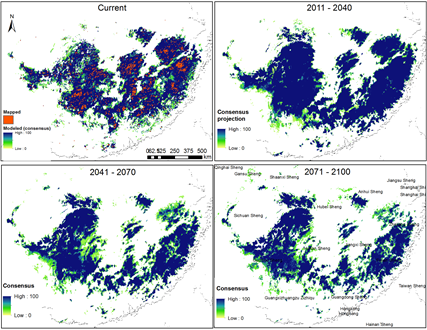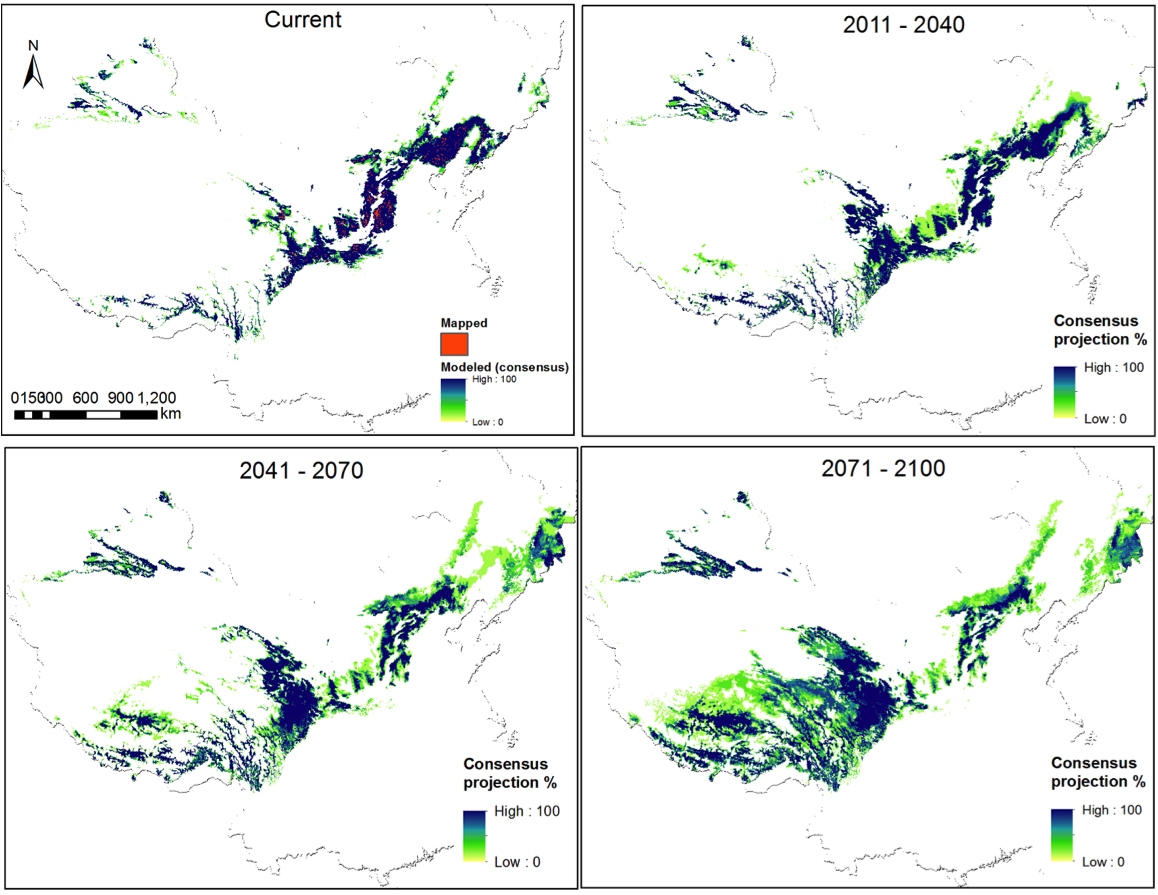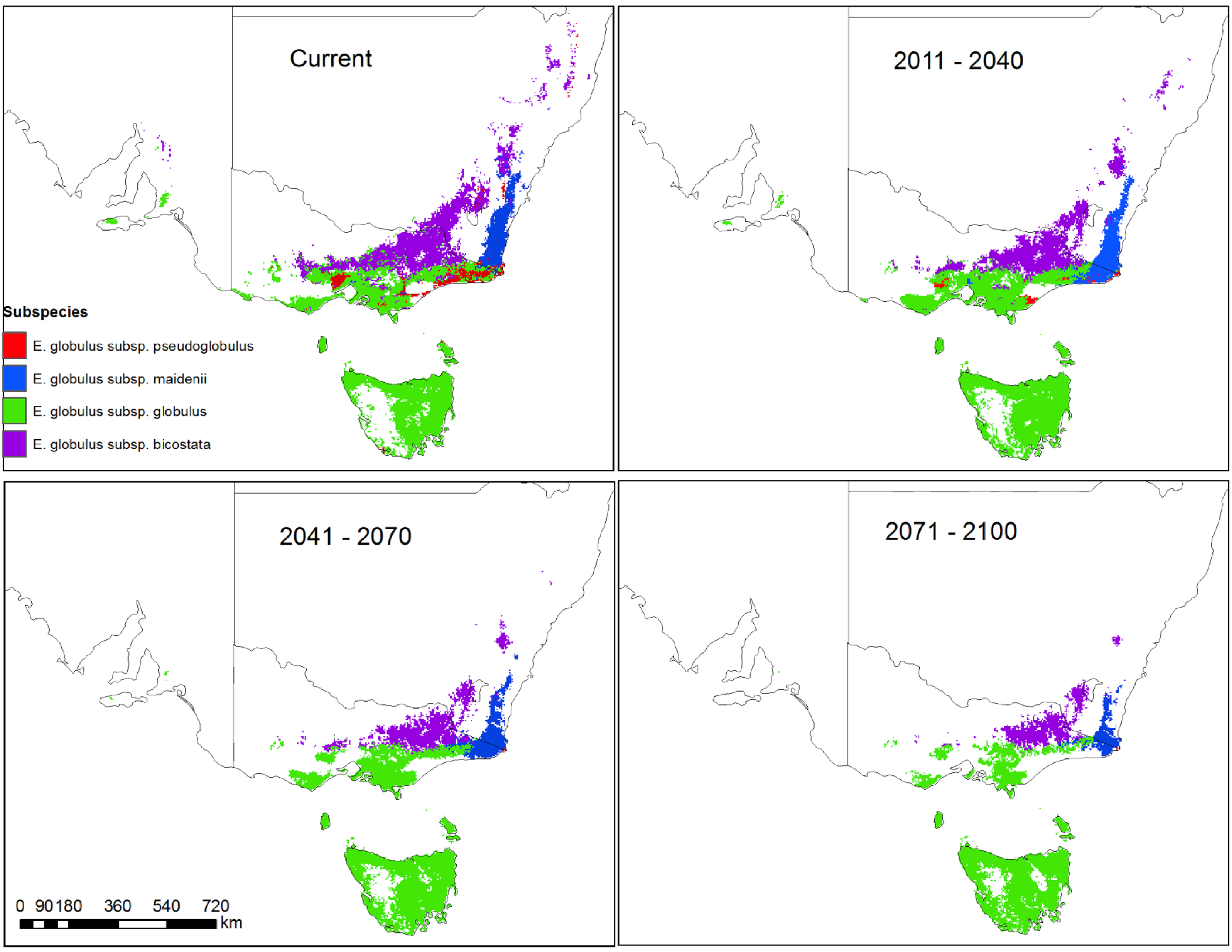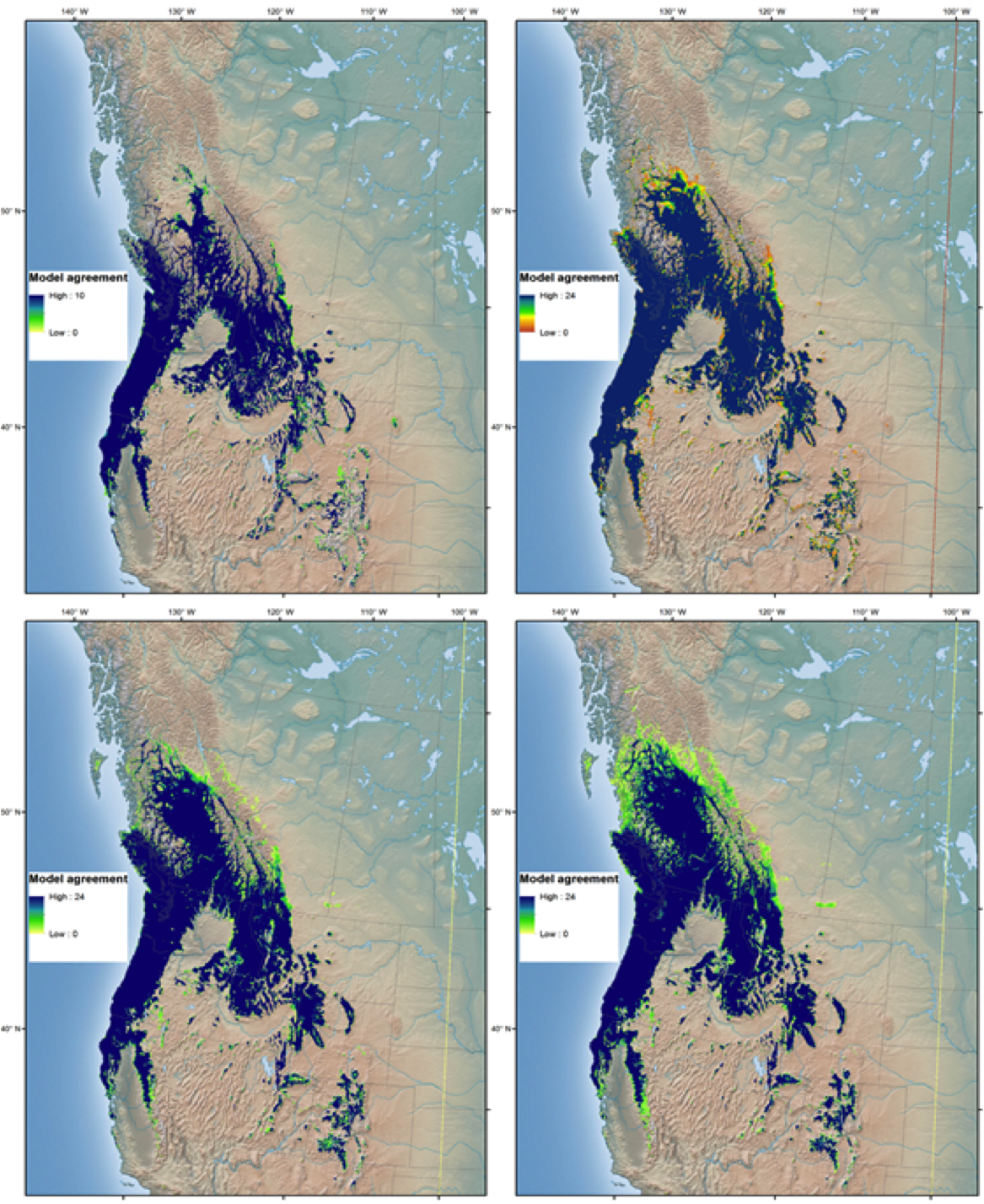Climate is the primary factor regulating the geographic distribution of forest tree species. Due to the slow migration of long-lived tree species, climate change will likely result in a mismatch between the climates that trees are adapted to and the climates that trees experience in the future. Until now, there has been a lack of studies that address this issue in the Asia-Pacific region, where several tree species are important contributors to ecosystem services and key to the social and economic stability of the region. Understanding the viability of these species in the areas they currently occupy and projecting their shift in future periods are essential steps in developing adaptive forest management strategies.
Niched-based ecological models are built based on relationships between the observed presence of a species (or forest ecosystem) and values of climate variables at those sites. They model the realized niche of a species, but it is important to note that the models predict the shift in distribution of the climate niche of a species, rather than the shift in distribution of the species per se.
Model Development
To develop these models, we used the R version of the Random Forests (RF) algorithm to model relationships between climate variables and the presence/absence of each of the five species. RF produces many classification trees, collectively called a ‘forest’, and aggregates the results over all trees. It generates importance values for each of the predictors, which we used to optimize the model and to identify the climate variables that are important in affecting the distribution of each species. The final RF models were built using an optimal combination of climate variables for each of the four species. We collected climate and vegetation data to generate maps illustrating the current distribution and projected distribution for each species for three time periods (2020s, 2050s and 2080s) based on the most up-to-date climate change scenarios from the IPCC AR5 GCMs. This provides clear visuals of the projected changes in species distribution, as seen in the figures below. For more detail on model development and the application on the model, see Wang et al. 2016.
Application
Niche-based ecological models were developed for this project to predict the impacts of climate change on the distribution of five important tree species in the Asia-Pacific region:
- Chinese fir (Cunninghamia lanceolata)
- Chinese pine (Pinus tabuliformis)
- Masson pine (Pinus massoniana)
- Douglas fir (Pseudotsuga menziesii)
- Blue Gum (Eucalyptus globulus)
The following results are a summary of those found in Wang et al. 2016. For more detailed information, please refer to the results published in the paper.
Chinese fir
Chinese fir (Cunninghamia lanceolata) is one of the most socially and economically important subtropical coniferous species in China. It occupies about 30% of all plantations in China and accounts for 25% of China’s national commercial timber production. Our results (Figure 1) suggest a substantial contraction in the geographic distribution of the climate niche of this species (-34%). The distribution contraction in the south is expected, as warmer climate conditions are expected to move into the current distribution, and the limited northward expansion is likely attributable to precipitation requirements of the species.

Figure 1. Maps of consensus projections of Chinese fir climate niche distribution for the current (1961-1990) conditions and three future periods (2020s, 2050s, 2080s) using 12 climate change scenarios from IPCC AR5 GMCs. More projections can be visualized using our Google Map based tools.
Chinese pine
Chinese pine (Pinus tabuliformis) is the most widely distributed conifer in North China. The consensus projections of this species are as expected, with contraction at the trailing edges and expansion in the leading ends. Instead of shifting northward, our projected climate niche for this species shifts mostly westward. This is not a surprise based on the topography in China, as there is higher elevation in the west. The total area of climate niche for this species is projected to increase substantially (about 50%). Chinese pine is also a drought tolerant forest tree species with a relatively fast growth rate, suggesting that this species may play an important role in forestation in China in the future.
 Figure 2. Maps of consensus projections of Chinese pine climate niche distribution for the current (1961-1990) conditions and three future periods (2020s, 2050s, 2080s).
Figure 2. Maps of consensus projections of Chinese pine climate niche distribution for the current (1961-1990) conditions and three future periods (2020s, 2050s, 2080s).
Masson pine
Masson pine (Pinus massoniana), along with Chinese fir, is the most socially and economically important subtropical coniferous species in China. The climate niche distribution of this species is projected to contract (-17%), with no substantial northward shift similar to Chinese fir. The contraction is projected to occur mostly at the trailing end of its current distribution in the south. This contrasts the projections for Chinese fir, for which the contraction is also expected to occur in the central distribution areas. This is probably attributable to the broader climate niche of this species and suggests that Masson pine may provide a good alternative to Chinese fir in species selection for reforestation and afforestation in the future climate.
Figure 3. Maps of consensus projections of Masson pine climate niche distribution for the current (1961-1990) conditions and three future periods (2020s, 2050s, 2080s).
Douglas fir
Douglas fir (Pseudotsuga menziesii) is one of the world’s best timber producers and yields more timber than any other tree in North America. The future projections of this species follow a typical northward and upward shift in the geographic distribution of its climate niche. A substantial expansion in the climate niche area of this species is projected, which will be particularly favorable in British Columbia, Canada, where the expansion would mostly occur. Preparation for the selection of seed sources and seed production should be seriously considered to take advantage of this opportunity.
Figure 4. Maps of consensus projections of Douglas fir climate niche distribution for the current (1961-1990) conditions and three future periods (2020s, 2050s, 2080s)
Blue Gum
Blue Gum (Eucalyptus globulus) is one of the most widely cultivated trees native to Australia. It has four subspecies distributed in the South states, including Tasmania Island. For the species as a whole, the climate niche geographic distribution is projected to shift southward towards cooler conditions. However, the shift is limited by ocean at the leading edge, and results in a contraction in the total climate niche area, with the level of contraction varying considerably among subspecies. The most impacted subspecies are E. glibulus ssp. pseudoglobulus and E. glibulus ssp. Bicostata. The climate niches of these two subspecies are predicted to almost completely disappear and contract by 50% by 2050, respectively.

Figure 5. Maps of consensus projections of the four subspecies of Blue Gum climate niche distribution for the current (1961-1990) conditions and three future periods (2020s, 2050s, 2080s).
Significance of niche-based ecological models
Modeling the climate niches of forest tree species and projecting their future shifts provides a scientific basis for the assessment of climate change impacts.These maps, including areas both currently occupied and unoccupied but climatically suitable for the species, will be useful for afforestation and ecosystem restoration using these species. Important climate variables identified for each species also help us to better understand the relationships between species distribution and climate conditions. The benefits of this model can be expanded to species and locations other than those examined in this phase of the project, through the application of this model in the next phase and by other researchers. The development of this model has provided a solid basis for the assessment of climate change impacts on these species, and for the development of adaptive strategies in forest resources management under a changing climate.
Work In Progress
For the second phase of the project, we will expand the application of niche-based models to include more species as well as tropical and sub-tropical ecosystems. The economies of focus will be China, Chinese Taipei, Laos, Malaysia, and Myanmar. In China, we will model two larch (Larix gmelinii and L. olgensis) species, Scots pine (Pinus sylvestris), Yunnan Pine (Pinus Yunnanensis), black locust (Robinia pseudoacacia), Chinese cork oak (Quercus variabilis), aspen (Populus tremula), and moso bamboo (Phyllostachys edulis). In Chinese Taipei, we will model Cyclobalanopsis longinux (syn. Quercus longinux) and Lithocarpus megalophyllus. For all economies, regional forest vegetation types will be modelled in order to map the spatial distribution of ecotypes.
Publications
Wang, T. (2014). Consensus projections of future climate niches for four major forest tree species in Asia Pacific. [Manuscript].
Wang, T., Wang, G., Innes, J., Nitschke, C., and Kang, H. (2016). Climatic niche models and their consensus projections for future climates for four major forest tree species in the Asia-Pacific region. Forest Ecology and Management, 360: 357-366.


